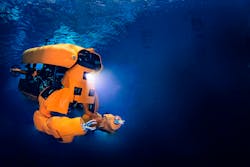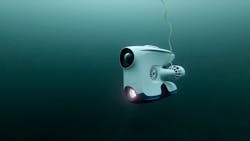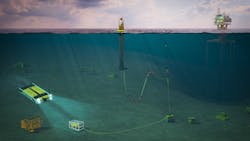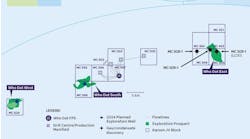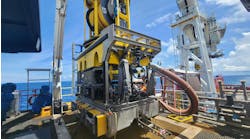As the oil and gas industry recovers and the offshore renewable energy market grows, use of remotely operated vehicles (ROV) and autonomous underwater vehicles (AUV) increases. Advances in subsea robotics not only improve inspection, maintenance, and repair (IMR) operations but also lower their environmental footprint.
The following highlights some of the notable developments in ROVs and AUVs.
Houston Mechatronics Inc. (HMI) has developed and is now commercializing an all-electric subsea robotic transformer. The Aquanaut can transform from an AUV into an ROV in less than 30 seconds, according to President and CEO Nic Radford. The tetherless subsea vehicle has a working range of 200 km (124 mi), 3,000 m (9,842 ft) depth rating, and 24-hour endurance period.
Founded in 2014, the Webster, Texas-based company started developing its flagship product in 2017. One-third of HMI’s 75 employees have worked at NASA’s Johnson Space Center in Houston. Radford said the name Aquanaut honors the heritage of Robonaut, NASA’s humanoid robot.
In 2020, HMI entered a collaboration agreement with Stinger Technology AS. The company will provide the AUV/ROV and necessary services needed to target and execute IRM operations within the Norwegian oil and gas market. This year Aquanaut will be in Norway finalizing product qualifications in order to be ready for commercial applications in 2022.
The company will also supply Aquanauts for Triumph Subsea Services’ construction vessels.
This year, Oceaneering is expected to complete final qualification trials for the Freedom autonomous subsea vehicle. This system is said to combine the work class functions of an ROV with the speed, range, and maneuverability of an AUV. The vehicle is supported by a docking station at the seabed and can operate in two modes: remotely piloted via tether to provide real-time control or operated in an autonomous and tetherless configuration. According to the company, Freedom boasts a working range of 200 km (124 mi), depth rating of 6,000 m (19,685 ft), maximum speed of 6 knots, and subsea deployments of up to six months.
The vehicle is said to be able to track pipelines only 1 m (3 ft) off the seabed to provide higher resolution data. Freedom’s software package offers a heightened level of obstacle detection, autonomous avoidance, and situational awareness. To avoid obstacles, the vehicle can re-plan its route and re-engage with the tracked pipeline. The modular design of the vehicle enables configuration for work scopes including infield inspection, long-range survey, and light intervention, the company said.
In September 2020, Oceaneering successfully docked the Freedom vehicle with Blue Logic and Equinor’s open-standard subsea docking station at its test facility in Tau, Norway. The vehicle launched from the quayside and landed while in autonomous mode using a tether only for Wi-FI feedback. The ‘universal’ docking station allows permanent deployment of underwater vehicles or drones by providing access to power for charging and communications for upload/download of inspection and assignment data. The docking station could be ready for commercial service as early as 2022, according to Blue Logic.
Earlier this year, Saipem’s Hydrone-R, the first commercially deployed underwater intervention drone (UID), started system integration tests for Equinor’s Njord field development in the Norwegian Sea. Sonsub, Saipem’s business division for Life of Field, Underwater Technology and Subsea Processing, has developed three vehicles: Hydrone-R, Hydrone-W, and Hydrone-S (or FlatFish).
The Hydrone-R is a resident hybrid ROV/AUV vehicle that is said to be able to operate subsea for more than a year to a water depth of 3,000 m (9,842 ft). It can also execute light intervention tasks and autonomous inspections. Its battery system provides 12 hours of autonomy and an inspection span of more than 10 km (6 mi), according to the company.
The Hydrone-W is an all-electric work class ROV that is designed to be fully remotely controlled from an onshore control center. It can also support subsea construction activities.
Equinor awarded Saipem the first ever offshore oil and gas service contract for subsea drones in 2019. The 10-year contract covers use of the Hydrone-R and Hydrone-W at the Njord field. The scope of work encompasses ROV and UID services to support drilling activities, as well as the entire plan of inspections and interventions on the Njord subsea assets.
Kongsberg Maritime recently launched the next generation of its HUGIN AUV. The HUGIN Endurance boosts operational duration to about 15 days, enabling extended survey and inspection missions far from shore. This longevity allows the new AUV to undertake extensive missions without the support of a mothership. It is capable of mission ranges up to 2,200 km (1,367 mi), according to the company. This is equivalent to the sailing distance from New York City to Cuba.
The company has added its Maritime Broadband Radio (MBR) communications system to the AUV’s payload. This allows the vehicle to surface and share large quantities of data swiftly with any suitably equipped installation, such as another vessel, shore station, or a wind turbine fitted with an MBR antenna.
The new AUV can be equipped with a wide swath multibeam echosounder, sub-bottom profiler and magnetometer, together with other sensors to detect parameters such as methane, current and turbidity.
According to the company, this proven portfolio of hydroacoustic sensors, communications and other technologies – teamed with operational range – ensures that the AUV is well equipped for advanced situational awareness scanning, and mapping/inspection activities for far-field applications such as offshore wind farms.
Richard Mills, vice president of Marine Robotics Sales, Kongsberg Maritime, said: “Teaming long endurance with large area coverage capabilities allows a single AUV to map areas up to 1,100 sq km [425 sq mi] in a single mission – a target impossible until now. With its unprecedented long-range capability and advanced communications, HUGIN Endurance sets a new standard for autonomous subsea mapping and inspection, yielding unmatched operational flexibility, efficiency, and sustainability.”
In early 2020, Blueye Robotics introduced the Blueye Pro ROV. The 9-kilogram (20-lb) underwater drone is ready to be deployed in a few minutes with minimal training. Users operate the ROV with the Blueye app and a wireless controller for iOS and Android smartphones and tablets. The 485 x 257 x 354 mm (19 x 10 x 14 in.) ROV features a camera tilt-function that allows users to increase their vertical field of view. It has a depth rating of 305 m (1,000 ft) and two-hour battery life.
Last year, the drone was deployed from the jackup Maersk Integrator to inspect conductor guides at Aker BP’s Ivar Aasen field in the central Norwegian North Sea.
Wave energy power solutions
Long-term or permanent deployment underwater drones are expected to reduce the carbon footprint and cost of subsea operations. As a result, the industry is exploring how wave energy technology can be used to power AUVs.
Ocean Power Technologies Inc. (OPT), Modus Seabed Intervention, and Saab Seaeye are developing a solution for carbon-free subsea AUV residency. This system is designed for autonomous offshore operations with the OPT PowerBuoy power and communications platform at its core. Via an integrated mooring and subsea power/data transmission cable, a PowerBuoy can provide carbon-free power to a seabed docking station to recharge an AUV while enabling secure data transmission to and from shore-based operations anywhere in the world.
The autonomous resident AUV system concept has been jointly submitted for US government development and demonstration project funding consideration.
George Kirby, OPT president and CEO, said: “We believe a self-contained system powered by an OPT PowerBuoy and exempt from existing ocean infrastructure has the potential to revolutionize the industrial use of AUVs and make long-term residency a cost-effective reality.
“Modus Seabed Intervention’s experience with advanced technology development efforts in subsea docking with Saab Seaeye’s market-leading hybrid AUV enables autonomous offshore operations and we believe it is a natural fit for our environmentally sound PowerBuoy ocean power and communications technology.”
Finally, later this year C-Power is expected to start a six-month sea trial of its SeaRAY autonomous offshore power system (AOPS) at the US Navy’s wave energy testing site in Hawaii. From shore, operator Hibbard Inshore will remotely program and monitor a Saab Seaeye Sabertooth hybrid AUV during what is said to be the first ever instance of an in situ renewable energy system supporting a subsea resident vehicle. Equipped with the R2Sonic Sonic 2024 multibeam echosounder, the untethered Sabertooth will patrol the surrounding area to collect sonar imagery of the seafloor and underwater infrastructure. After each mission, that imagery will be communicated back to shore and the AUV recharged via the SeaRAY AOPS.
According to C-Power, the goal is to demonstrate how the system can fill the market’s immediate need for offshore power, energy storage, and real-time data and communications for resident marine systems.
